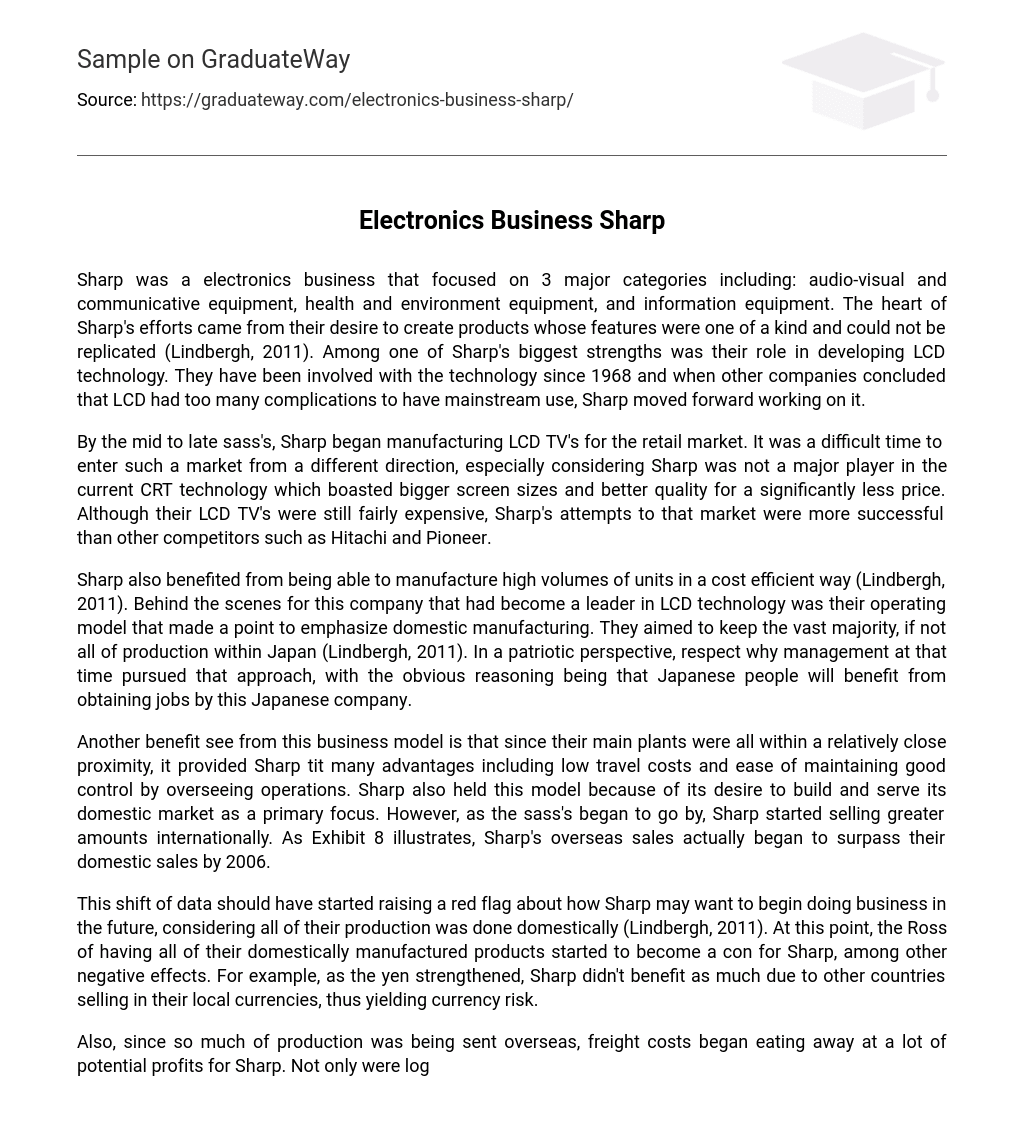Sharp was a electronics business that focused on 3 major categories including: audio-visual and communicative equipment, health and environment equipment, and information equipment. The heart of Sharp’s efforts came from their desire to create products whose features were one of a kind and could not be replicated (Lindbergh, 2011). Among one of Sharp’s biggest strengths was their role in developing LCD technology. They have been involved with the technology since 1968 and when other companies concluded that LCD had too many complications to have mainstream use, Sharp moved forward working on it.
By the mid to late sass’s, Sharp began manufacturing LCD TV’s for the retail market. It was a difficult time to enter such a market from a different direction, especially considering Sharp was not a major player in the current CRT technology which boasted bigger screen sizes and better quality for a significantly less price. Although their LCD TV’s were still fairly expensive, Sharp’s attempts to that market were more successful than other competitors such as Hitachi and Pioneer.
Sharp also benefited from being able to manufacture high volumes of units in a cost efficient way (Lindbergh, 2011). Behind the scenes for this company that had become a leader in LCD technology was their operating model that made a point to emphasize domestic manufacturing. They aimed to keep the vast majority, if not all of production within Japan (Lindbergh, 2011). In a patriotic perspective, respect why management at that time pursued that approach, with the obvious reasoning being that Japanese people will benefit from obtaining jobs by this Japanese company.
Another benefit see from this business model is that since their main plants were all within a relatively close proximity, it provided Sharp tit many advantages including low travel costs and ease of maintaining good control by overseeing operations. Sharp also held this model because of its desire to build and serve its domestic market as a primary focus. However, as the sass’s began to go by, Sharp started selling greater amounts internationally. As Exhibit 8 illustrates, Sharp’s overseas sales actually began to surpass their domestic sales by 2006.
This shift of data should have started raising a red flag about how Sharp may want to begin doing business in the future, considering all of their production was done domestically (Lindbergh, 2011). At this point, the Ross of having all of their domestically manufactured products started to become a con for Sharp, among other negative effects. For example, as the yen strengthened, Sharp didn’t benefit as much due to other countries selling in their local currencies, thus yielding currency risk.
Also, since so much of production was being sent overseas, freight costs began eating away at a lot of potential profits for Sharp. Not only were logistics an issue, but nearby countries like Korea and Taiwan that produced similar products had the benefit of not having to pay the high infrastructure and tax costs that Sharp did in Japan. These main actors, among others saw Sharp start to report losses by 2009 (Lindbergh, 2011). The year 2009 also plays a significance on the world scale as a time of economic hardships.
Sales were forecasted to fall and Kathy knew that new ideas were vital for Sharp to stay alive. He began focusing on expanding Sharp into China, where until then flat panel TV’s were mainly possessed by higher income families. The western world had already caught up to the trend by then, so Kathy felt that his best bet was to focus on the middle to lower income earners of the huge market of China. Not only that, but the general pressure of succeeding in oral markets began to face Sharp’s management with the notions to have to expand their business into different major markets around the world.
Kathy admitted that Sharp was facing the struggle of having to reform its identity due to the world economic pressures, and that he was narrowing his choices (Lindbergh, 2011). Kathy had already been the cause of the new Assai plant, which, with the help of a deal with Sony that would see Sony purchase excess supply, gave Sharp an efficient manufacturing location and also reducing some of its investment risk. His plans for stretching overseas, however, aimed to focus ore on the knowledge aspect of the business, rather than physical plants.
Sharp had been in contact with a couple of Chinese companies interested in purchasing some of Sharp’s previously used equipment and combining on joint ventures (Lindbergh, 2011). I strongly believe that Sharp should indeed make these moves. China is known as being the world’s most populated country, and there are a few key reasons why focusing a good amount of attention there would probably be successful for Sharp. For example, Kathy admitted his desire to target the middle to lower class citizens who have not yet joined in n the LCD mainstream.
Also, the business propositions for joint ventures in a country so heavily populated would sure help to avoid some of the hardships that Sharp found eating away their profit margins under their previous operating model. As is with any trust overseas, security of information may be a tough pill to swallow for Kathy and other Sharp executives. However, if that kind of security and trust could be assured one way or another, I believe that a move to China, and future ventures of similar nature would help to bring Sharp back in a strong fashion.





